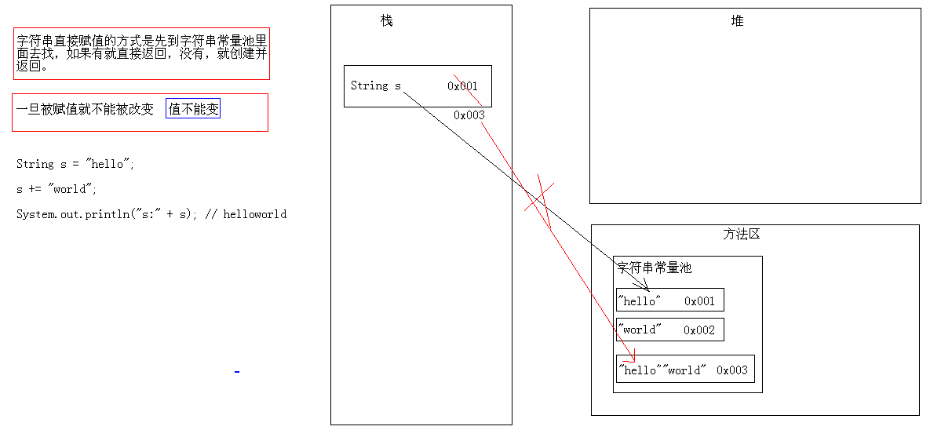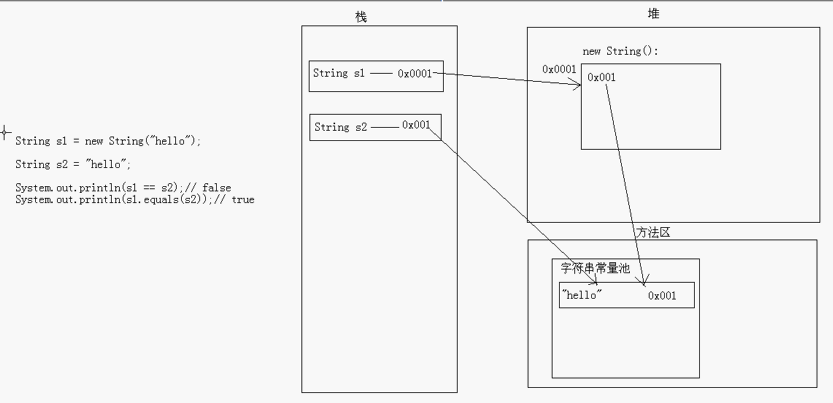String构造方法
package cn.itcast_01; /* * 字符串:就是由多个字符组成的一串数据。也可以看成是一个字符数组。 * 通过查看API,我们可以知道 * A:字符串字面值"abc"也可以看成是一个字符串对象。 * B:字符串是常量,一旦被赋值,就不能被改变。 * * 构造方法: * public String():空构造 * public String(String original):把字符串常量值转成字符串 * * 字符串的方法: * public int length():返回此字符串的长度。 */ public class StringDemo { public static void main(String[] args) { // public String():空构造 String s1 = new String(); System.out.println("s1:" + s1); System.out.println("s1.length():" + s1.length()); System.out.println("--------------------------"); //s1: //s1.length():0 //public String(String original):把字符串常量值转成字符串 String s6 = new String("abcde"); System.out.println("s6:" + s6); System.out.println("s6.length():" + s6.length()); System.out.println("--------------------------"); //字符串字面值"abc"也可以看成是一个字符串对象。 String s7 = "abcde"; System.out.println("s7:"+s7); System.out.println("s7.length():"+s7.length()); } }
字符串的特点:一旦被赋值,就不能改变。
但是引用可以改变
package cn.itcast_02; /* * 字符串的特点:一旦被赋值,就不能改变。 */ public class StringDemo { public static void main(String[] args) { String s = "hello"; s += "world"; System.out.println("s:" + s); // helloworld } }
图解:

String s = new String(“hello”)和 String s = “hello”;的区别?
String字面值对象和构造方法创建对象的区别
package cn.itcast_02; /* * String s = new String(“hello”)和String s = “hello”;的区别? * 有。前者会创建2个对象,后者创建1个对象。 * * ==:比较引用类型比较的是地址值是否相同 * equals:比较引用类型默认也是比较地址值是否相同,而String类重写了equals()方法,比较的是内容是否相同。 */ public class StringDemo2 { public static void main(String[] args) { String s1 = new String("hello"); String s2 = "hello"; System.out.println(s1 == s2);// false System.out.println(s1.equals(s2));// true } }
图解:

String s5 = "hello"; String s6 = "hello"; System.out.println(s5 == s6);// 字符串字面量,直接从内存找,所以true System.out.println(s5.equals(s6));// true
package cn.itcast_02; /* * 看程序写结果 * 字符串如果是变量相加,先开空间,在拼接。 * 字符串如果是常量相加,是先加,然后在常量池找,如果有就直接返回,否则,就创建。 */ public class StringDemo4 { public static void main(String[] args) { String s1 = "hello"; String s2 = "world"; String s3 = "helloworld"; System.out.println(s3 == s1 + s2);// false。字符串如果是变量相加,先开空间,再拼接。 System.out.println(s3.equals((s1 + s2)));// true System.out.println(s3 == "hello" + "world");//true。字符串如果是常量相加,是先加,然后在常量池找,如果有就直接返回,否则,就创建。 System.out.println(s3.equals("hello" + "world"));// true // 通过反编译看源码,我们知道这里已经做好了处理。 // System.out.println(s3 == "helloworld"); // System.out.println(s3.equals("helloworld")); } }
String类的判断功能:
package cn.itcast_03; /* * String类的判断功能: * boolean equals(Object obj):比较字符串的内容是否相同,区分大小写 * boolean equalsIgnoreCase(String str):比较字符串的内容是否相同,忽略大小写 * boolean contains(String str):判断大字符串中是否包含小字符串 * boolean startsWith(String str):判断字符串是否以某个指定的字符串开头 * boolean endsWith(String str):判断字符串是否以某个指定的字符串结尾 * boolean isEmpty():判断字符串是否为空。 * * 注意: * 字符串内容为空和字符串对象为空。 * String s = "";//对象存在,所以可以调方法 * String s = null;//对象不存在,不能调方法 */ public class StringDemo { public static void main(String[] args) { // 创建字符串对象 String s1 = "helloworld"; String s2 = "helloworld"; String s3 = "HelloWorld"; // boolean equals(Object obj):比较字符串的内容是否相同,区分大小写 System.out.println("equals:" + s1.equals(s2)); System.out.println("equals:" + s1.equals(s3)); System.out.println("-----------------------"); // boolean equalsIgnoreCase(String str):比较字符串的内容是否相同,忽略大小写 System.out.println("equals:" + s1.equalsIgnoreCase(s2)); System.out.println("equals:" + s1.equalsIgnoreCase(s3)); System.out.println("-----------------------"); // boolean contains(String str):判断大字符串中是否包含小字符串 System.out.println("contains:" + s1.contains("hello")); System.out.println("contains:" + s1.contains("hw")); System.out.println("-----------------------"); // boolean startsWith(String str):判断字符串是否以某个指定的字符串开头 System.out.println("startsWith:" + s1.startsWith("h")); System.out.println("startsWith:" + s1.startsWith("hello")); System.out.println("startsWith:" + s1.startsWith("world")); System.out.println("-----------------------"); // 练习:boolean endsWith(String str):判断字符串是否以某个指定的字符串结尾这个自己玩 // boolean isEmpty():判断字符串是否为空。 System.out.println("isEmpty:" + s1.isEmpty()); String s4 = ""; String s5 = null; System.out.println("isEmpty:" + s4.isEmpty()); // NullPointerException // s5对象都不存在,所以不能调用方法,空指针异常 // System.out.println("isEmpty:" + s5.isEmpty()); } }
String类的获取功能
package cn.itcast_04; /* * String类的获取功能 * int length():获取字符串的长度。 * char charAt(int index):获取指定索引位置的字符 * int indexOf(int ch):返回指定字符在此字符串中第一次出现处的索引。 * 为什么这里是int类型,而不是char类型? * 原因是:'a'和97其实都可以代表'a'。如果里面写char,就不能写数字97了 * int indexOf(String str):返回指定字符串在此字符串中第一次出现处的索引。 * int indexOf(int ch,int fromIndex):返回指定字符在此字符串中从指定位置后第一次出现处的索引。 * int indexOf(String str,int fromIndex):返回指定字符串在此字符串中从指定位置后第一次出现处的索引。 * String substring(int start):从指定位置开始截取字符串,默认到末尾。 * String substring(int start,int end):从指定位置开始到指定位置结束截取字符串。 */ public class StringDemo { public static void main(String[] args) { // 定义一个字符串对象 String s = "helloworld"; // int length():获取字符串的长度。 System.out.println("s.length:" + s.length());//10 System.out.println("----------------------"); // char charAt(int index):获取指定索引位置的字符 System.out.println("charAt:" + s.charAt(7));// System.out.println("----------------------"); // int indexOf(int ch):返回指定字符在此字符串中第一次出现处的索引。 System.out.println("indexOf:" + s.indexOf('l')); System.out.println("----------------------"); // int indexOf(String str):返回指定字符串在此字符串中第一次出现处的索引。 System.out.println("indexOf:" + s.indexOf("owo")); System.out.println("----------------------"); // int indexOf(int ch,int fromIndex):返回指定字符在此字符串中从指定位置后第一次出现处的索引。 System.out.println("indexOf:" + s.indexOf('l', 4)); System.out.println("indexOf:" + s.indexOf('k', 4)); // -1 System.out.println("indexOf:" + s.indexOf('l', 40)); // -1 System.out.println("----------------------"); // 自己练习:int indexOf(String str,int // fromIndex):返回指定字符串在此字符串中从指定位置后第一次出现处的索引。 // String substring(int start):从指定位置开始截取字符串,默认到末尾。包含start这个索引 System.out.println("substring:" + s.substring(5)); System.out.println("substring:" + s.substring(0)); System.out.println("----------------------"); // String substring(int start,intend):从指定位置开始到指定位置结束截取字符串。 //包括start索引但是不包end索引 System.out.println("substring:" + s.substring(3, 8)); System.out.println("substring:" + s.substring(0, s.length())); } }
字符串遍历:
package cn.itcast_04; /* * 需求:遍历获取字符串中的每一个字符 * * 分析: * A:如何能够拿到每一个字符呢? * char charAt(int index) * B:我怎么知道字符到底有多少个呢? * int length() */ public class StringTest { public static void main(String[] args) { // 定义字符串 String s = "helloworld"; for (int x = 0; x < s.length(); x++) { System.out.println(s.charAt(x)); } } }
统计大写字母,小写字母,数字在字符串中的个数
package cn.itcast_04; /* * 需求:统计一个字符串中大写字母字符,小写字母字符,数字字符出现的次数。(不考虑其他字符) * 举例: * "Hello123World" * 结果: * 大写字符:2个 * 小写字符:8个 * 数字字符:3个 * * 分析: * 前提:字符串要存在 * A:定义三个统计变量 * bigCount=0 * smallCount=0 * numberCount=0 * B:遍历字符串,得到每一个字符。 * length()和charAt()结合 * C:判断该字符到底是属于那种类型的 * 大:bigCount++ * 小:smallCount++ * 数字:numberCount++ * * 这道题目的难点就是如何判断某个字符是大的,还是小的,还是数字的。 * ASCII码表: * 0 48 * A 65 * a 97 * 虽然,我们按照数字的这种比较是可以的,但是想多了,有比这还简单的 * char ch = s.charAt(x); * * if(ch>='0' && ch<='9') numberCount++ * if(ch>='a' && ch<='z') smallCount++ * if(ch>='A' && ch<='Z') bigCount++ * D:输出结果。 * * 练习:把给定字符串的方式,改进为键盘录入字符串的方式。 */ public class StringTest2 { public static void main(String[] args) { //定义一个字符串 String s = "Hello123World"; //定义三个统计变量 int bigCount = 0; int smallCount = 0; int numberCount = 0; //遍历字符串,得到每一个字符。 for(int x=0; x<s.length(); x++){ char ch = s.charAt(x); //判断该字符到底是属于那种类型的,char类型会转成int类型 if(ch>='a' && ch<='z'){ smallCount++; }else if(ch>='A' && ch<='Z'){ bigCount++; }else if(ch>='0' && ch<='9'){ numberCount++; } } //输出结果。 System.out.println("大写字母"+bigCount+"个"); System.out.println("小写字母"+smallCount+"个"); System.out.println("数字"+numberCount+"个"); } }
String的转换功能:
package cn.itcast_05; /* * String的转换功能: * byte[] getBytes():把字符串转换为字节数组。 * char[] toCharArray():把字符串转换为字符数组。 * static String valueOf(char[] chs):把字符数组转成字符串。 * static String valueOf(int i):把int类型的数据转成字符串。 * 注意:String类的valueOf方法可以把任意类型的数据转成字符串。 * String toLowerCase():把字符串转成小写。 * String toUpperCase():把字符串转成大写。 * String concat(String str):把字符串拼接。 */ public class StringDemo { public static void main(String[] args) { // 定义一个字符串对象 String s = "JavaSE"; // byte[] getBytes():把字符串转换为字节数组。 byte[] bys = s.getBytes(); for (int x = 0; x < bys.length; x++) { System.out.println(bys[x]); } System.out.println("----------------"); // char[] toCharArray():把字符串转换为字符数组。 char[] chs = s.toCharArray(); for (int x = 0; x < chs.length; x++) { System.out.println(chs[x]); } System.out.println("----------------"); // static String valueOf(char[] chs):把字符数组转成字符串。 String ss = String.valueOf(chs); System.out.println(ss); System.out.println("----------------"); // static String valueOf(int i):把int类型的数据转成字符串。 int i = 100; String sss = String.valueOf(i); System.out.println(sss); System.out.println("----------------"); // String toLowerCase():把字符串转成小写。 System.out.println("toLowerCase:" + s.toLowerCase()); System.out.println("s:" + s); // System.out.println("----------------"); // String toUpperCase():把字符串转成大写。 System.out.println("toUpperCase:" + s.toUpperCase()); System.out.println("----------------"); // String concat(String str):把字符串拼接。 String s1 = "hello"; String s2 = "world"; String s3 = s1 + s2; String s4 = s1.concat(s2); System.out.println("s3:"+s3); System.out.println("s4:"+s4); } }
把一个字符串的首字母转成大写,其余为小写。(只考虑英文大小写字母字符)
package cn.itcast_05; /* * 需求:把一个字符串的首字母转成大写,其余为小写。(只考虑英文大小写字母字符) * 举例: * helloWORLD * 结果: * Helloworld * * 分析: * A:先获取第一个字符 * B:获取除了第一个字符以外的字符 * C:把A转成大写 * D:把B转成小写 * E:C拼接D */ public class StringTest { public static void main(String[] args) { // 定义一个字符串 String s = "helloWORLD"; // 先获取第一个字符 String s1 = s.substring(0, 1); // 获取除了第一个字符以外的字符 String s2 = s.substring(1); // 把A转成大写 String s3 = s1.toUpperCase(); // 把B转成小写 String s4 = s2.toLowerCase(); // C拼接D String s5 = s3.concat(s4); System.out.println(s5); // 优化后的代码 // 链式编程 String result = s.substring(0, 1).toUpperCase() .concat(s.substring(1).toLowerCase()); System.out.println(result); } }
String类的其他功能:
替换功能:
去除字符串两空格
按字典顺序比较两个字符串
package cn.itcast_06; /* * String类的其他功能: * * 替换功能: * String replace(char old,char new) * String replace(String old,String new) * * 去除字符串两空格 * String trim() * * 按字典顺序比较两个字符串 * int compareTo(String str) * int compareToIgnoreCase(String str) */ public class StringDemo { public static void main(String[] args) { // 替换功能 String s1 = "helloworld"; String s2 = s1.replace('l', 'k'); String s3 = s1.replace("owo", "ak47"); System.out.println("s1:" + s1); System.out.println("s2:" + s2); System.out.println("s3:" + s3); System.out.println("---------------"); // 去除字符串两空格 String s4 = " hello world "; String s5 = s4.trim(); System.out.println("s4:" + s4 + "---"); System.out.println("s5:" + s5 + "---"); // 按字典顺序比较两个字符串 String s6 = "hello"; String s7 = "hello"; String s8 = "abc"; String s9 = "xyz"; System.out.println(s6.compareTo(s7));// 0 System.out.println(s6.compareTo(s8));// 7 System.out.println(s6.compareTo(s9));// -16 } }
把数组中的数据按照指定个格式拼接成一个字符串
package cn.itcast_07; /* * 需求:把数组中的数据按照指定个格式拼接成一个字符串 * 举例: * int[] arr = {1,2,3}; * 输出结果: * "[1, 2, 3]" * 分析: * A:定义一个字符串对象,只不过内容为空 * B:先把字符串拼接一个"[" * C:遍历int数组,得到每一个元素 * D:先判断该元素是否为最后一个 * 是:就直接拼接元素和"]" * 不是:就拼接元素和逗号以及空格 * E:输出拼接后的字符串 * * 把代码用功能实现。 */ public class StringTest2 { public static void main(String[] args) { // 前提是数组已经存在 int[] arr = { 1, 2, 3 }; // 写一个功能,实现结果 String result = arrayToString(arr); System.out.println("最终结果是:" + result); } /* * 两个明确: 返回值类型:String 参数列表:int[] arr */ public static String arrayToString(int[] arr) { // 定义一个字符串 String s = ""; // 先把字符串拼接一个"[" s += "["; // 遍历int数组,得到每一个元素 for (int x = 0; x < arr.length; x++) { // 先判断该元素是否为最后一个 if (x == arr.length - 1) { // 就直接拼接元素和"]" s += arr[x]; s += "]"; } else { // 就拼接元素和逗号以及空格 s += arr[x]; s += ", "; } } return s; } }
字符串反转
package cn.itcast_07; import java.util.Scanner; /* * 字符串反转 * 举例:键盘录入”abc” * 输出结果:”cba” * * 分析: * A:键盘录入一个字符串 * B:定义一个新字符串 * C:倒着遍历字符串,得到每一个字符 * a:length()和charAt()结合 * b:把字符串转成字符数组 * D:用新字符串把每一个字符拼接起来 * E:输出新串 */ public class StringTest3 { public static void main(String[] args) { // 键盘录入一个字符串 Scanner sc = new Scanner(System.in); System.out.println("请输入一个字符串:"); String line = sc.nextLine(); String s = myReverse(line); System.out.println("实现功能后的结果是:" + s); } /* * 两个明确: 返回值类型:String 参数列表:String */ public static String myReverse(String s) { // 定义一个新字符串 String result = ""; // 把字符串转成字符数组 char[] chs = s.toCharArray(); // 倒着遍历字符串,得到每一个字符 for (int x = chs.length - 1; x >= 0; x--) { // 用新字符串把每一个字符拼接起来 result += chs[x]; } return result; } }
统计大串中小串出现的次数
package cn.itcast_07; /* * 统计大串中小串出现的次数 * 举例: * 在字符串"woaijavawozhenaijavawozhendeaijavawozhendehenaijavaxinbuxinwoaijavagun" * 结果: * java出现了5次 * * 分析: * 前提:是已经知道了大串和小串。 * * A:定义一个统计变量,初始化值是0 * B:先在大串中查找一次小串第一次出现的位置 * a:索引是-1,说明不存在了,就返回统计变量 * b:索引不是-1,说明存在,统计变量++ * C:把刚才的索引+小串的长度作为开始位置截取上一次的大串,返回一个新的字符串,并把该字符串的值重新赋值给大串 * D:回到B */ public class StringTest5 { public static void main(String[] args) { // 定义大串 String maxString = "woaijavawozhenaijavawozhendeaijavawozhendehenaijavaxinbuxinwoaijavagun"; // 定义小串 String minString = "java"; // 写功能实现 int count = getCount(maxString, minString); System.out.println("Java在大串中出现了:" + count + "次"); } /* * 两个明确: 返回值类型:int 参数列表:两个字符串 */ public static int getCount(String maxString, String minString) { // 定义一个统计变量,初始化值是0 int count = 0; int index; //先查,赋值,判断 while((index=maxString.indexOf(minString))!=-1){ count++; maxString = maxString.substring(index + minString.length()); } return count; } }
